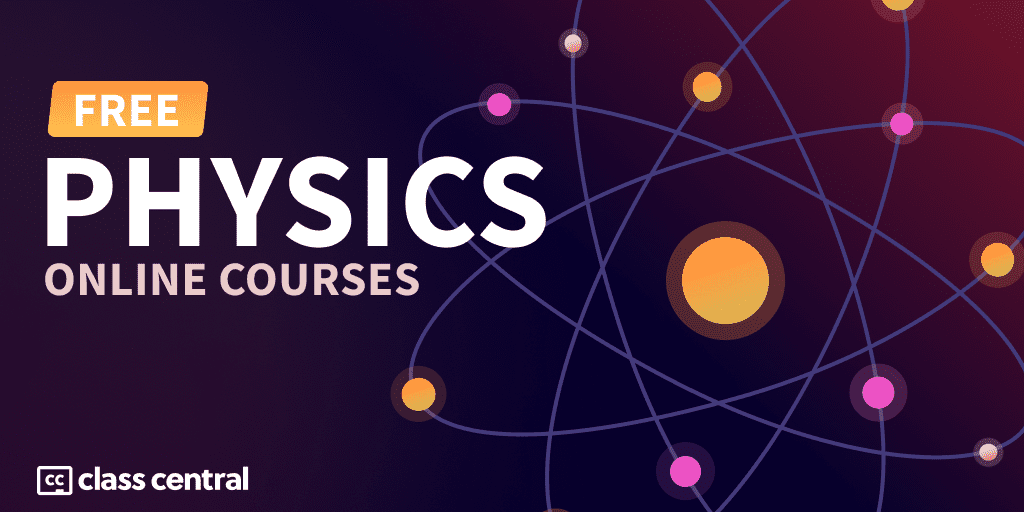1200+ Physics Online Courses You Can Take for Free
From celestial objects to the quantum world, get your physics knowledge on with this selection of courses.

From the expansion of ATLAS, CERN’s ongoing experiment to uncover the mysteries of subatomic particles, to the incredible images captured by the James Webb Space Telescope, NASA’s flagship astrophysics project, the field of physics is bubbling with activity.
As the field continues to grow, so does the number of physics online courses offered by the best universities around the world. Fortunately, we’ve been keeping track of them for you: there are currently over 1200+ free physics online courses listed on Class Central!
In this article, we’ve compiled a selection of physics courses on a wide variety of subfields. Happy learning!
Subjects
For your convenience, we’ve broken down the list by topic. Click on a subject to jump to the corresponding section:
- Introductory Physics
- Classical Mechanics
- Theoretical Physics
- Electromagnetism
- Thermodynamics and Statistical Mechanics
- Quantum mechanics
- Relativity
- Particle Physics
- Astrophysics
- Sounds and Acoustics
- Optics
So do take a look at the list below. Whatever your interest in physics — whether it’s introductory physics, Einstein’s relativity, or simple curiosity — dive in and increase your understanding of the basic building blocks of the world around us.
More Courses
And if you don’t find what you need below, have a look at our other collections of scientific courses:
- 200 Chemistry Courses to Expand Your Knowledge of the World
- 120+ Math Online Courses from the World’s Top Universities
- 100+ Free Online Courses and Webinars on AI in Healthcare
- 70+ Free Online Courses on Evolutionary Science
- Harvard Computer Science Courses with Free Certificate
You can find all our free certificates articles here.
Introduction to Physics Online Courses
- How Things Work: An Introduction to Physics via Coursera
- Intro to Physics via Udacity
- Space, Time and Einstein via World Science U
- The Finite Element Method for Problems in Physics via Coursera
- Fundamentals of Physics via YouTube
- Feynman Lectures on Physics via Independent
- Physics 101 – Forces and Kinematics via Coursera
- Physics by CrashCourse via YouTube
- Understanding Modern Physics III: Simplicity and Complexity via Coursera
- Physics, Astronomy, and Space: Teaching Secondary Science via FutureLearn
- Pre-University Physics via edX
- Physics 101 – Energy and Momentum via Coursera
- Frontier Physics, Future Technologies via FutureLearn
- Physics 111: Physics I via Study.com
- Physics of the Everyday via Brilliant
- Physics 101: Intro to Physics via Study.com
- Fundamental Physics via Study.com
- Physics 101 – Rotational Motion and Gravitation via Coursera
Classical Mechanics Online Courses
- Fluid Mechanics I via YouTube
- Fluid Mechanics – Concept and Derivation via YouTube
- Microstructural Evolution of Materials Part 1: Statistical Mechanics via edX
- Fundamentals of Fluid-Solid Interactions via Coursera
- Classical Mechanics via MIT OpenCourseWare
- Mechanics: Motion, Forces, Energy and Gravity, from Particles to Planets via Coursera
- Classical Mechanics via Brilliant
- Statistical Mechanics I: Statistical Mechanics of Particles via MIT OpenCourseWare
- Computational Fluid Mechanics – Airflow Around a Spoiler via Coursera
- Classical Mechanics – From Newtonian to Lagrangian Formulation via YouTube
- Exploring fluid mechanics using Wolfram notebook via Coursera
- Mechanics, Heat, Oscillations and Waves via YouTube
- Interfacial Fluid Mechanics via Swayam
- Fundamentals of Fluid Mechanics via Udemy
- Introduction to Classical Mechanics via YouTube
- Graduate Classical Mechanics Course – Northwestern, Fall 2020 via YouTube
- Classical Mechanics via YouTube
Theoretical Physics Online Courses
- The Einstein Revolution via edX
- Geometrical Anatomy of Theoretical Physics via YouTube
- The Myth of the Beginning of Time – String Theory and the Big Bang via YouTube
- Fundamental Lessons From String Theory via World Science U
- Loose Ends – String Theory and the Quest for the Ultimate Theory via YouTube
- String Theory and Holographic Duality via MIT OpenCourseWare
- Quantum Mechanics, Black Holes and String Theory via YouTube
- Gravitational Physics via Brilliant
- Fundamental Lessons From String Theory via YouTube
Electromagnetism Online Courses
- Fundamentos de Electromagnetismo para Ingeniería via edX
- Electricity and Magnetism, Part 1 via edX
- Physics 102 – AC Circuits and Maxwell’s Equations via Coursera
- Introduction to Electromagnetism via YouTube
- Effective Field Theory via MIT OpenCourseWare
- Electromagnetic Fields in 3-D via Swayam
- Electromagnetic Theory via YouTube
- Electromagnetic Compatibility Essentials via edX
- Introductory Electricity and Magnetism via edX
- AP® Physics 2 – Part 2: Electricity and Magnetism via edX
- Electrodynamics: Electric and Magnetic Fields via Coursera
- Electrodynamics via Coursera
- 电磁学 | Electromagnetism via edX
- Electrodynamics: Analysis of Electric Fields via Coursera
- PHYS102: Introduction to Electromagnetism via Saylor Academy
- Electrodynamics: An Introduction via Coursera
- Electromagnetism via YouTube
- Physics 102 – Electric Potential and DC Circuits via Coursera
- The Origin of Electromagnetism – An Unsolved Riddle via YouTube
- Physics 102 – Magnetic Fields and Faraday’s Law via Coursera
- La fisica: dall’elettromagnetismo all’ottica via edX
- Physics 102 – Electric Charges and Fields via Coursera
Thermodynamics and Statistical Mechanics Online Courses
- Introduzione alla fisica sperimentale: meccanica, termodinamica via Polimi OPEN KNOWLEDGE
- Thermodynamics via edX
- Introduction to Thermodynamics: Transferring Energy from Here to There via Coursera
- Introduzione alla fisica sperimentale: meccanica, termodinamica via Coursera
- Statistical Molecular Thermodynamics via Coursera
- Statistical Mechanics: Algorithms and Computations via Coursera
- Hypersonic Aerothermodynamics – Stanford Spring 2020-2021 via YouTube
- AP® Physics 2 – Part 1: Fluids and Thermodynamics via edX
- Basic Thermodynamics via YouTube
- Thermodynamics & Kinetics via MIT OpenCourseWare
- Energy and Thermodynamics via edX
- Fundamentals of Macroscopic and Microscopic Thermodynamics via Coursera
- Statistical Thermodynamics: Molecules to Machines via Coursera
- Thermodynamics & Kinetics via YouTube
- Non-Equilibrium Applications of Statistical Thermodynamics via Coursera
- Laws of Thermodynamics via YouTube
- Statistical Thermodynamics via Coursera
- Chemical Thermodynamics I: Thermodynamics and Statistical Mechanics via edX
- Introduction to Thermodynamics via FutureLearn
Quantum Mechanics Online Courses
- Quantum Mechanics for Everyone via edX
- Quantum Mechanics via edX
- Exploring Quantum Physics via Coursera
- The Discovery of the Higgs Boson via FutureLearn
- Quantum Mechanics for Scientists and Engineers 2 via edX
- Quantum Mechanics via Coursera
- Mécanique quantique via Coursera
- Quantum Physics II via MIT OpenCourseWare
- Understanding Modern Physics II: Quantum Mechanics and Atoms via Coursera
- Quantum Physics III (Spring 2018) via MIT OpenCourseWare
- Introductory Quantum Mechanics via YouTube
- Quantum Mechanics for Scientists and Engineers 1 via edX
- Foundations of Quantum Mechanics via Coursera
- Introductory Quantum Mechanics in Hindi via Swayam
- Quantum Mechanics for Engineers via Coursera
- Quantum Mechanics of Molecular Structures via edX
Relativity Online Courses
- Understanding Einstein: The Special Theory of Relativity via Coursera
- Special Relativity via World Science U
- Introduction to Special Relativity – January IAP 2021 via YouTube
- General Relativity via MIT OpenCourseWare
- Special Relativity via YouTube
- Explore Einstein’s theories of Relativity using Wolfram via Coursera
- Curved Spacetime in General Relativity via YouTube
- Special Theory of Relativity via YouTube
- Special Relativity via Brilliant
- Special Theory of Relativity via YouTube
- Understanding Modern Physics I: Relativity and Cosmology via Coursera
- General Relativity and Gravity – What Einstein Discovered via YouTube
Particle Physics Online Courses
- Particle Physics: an Introduction via Coursera
- Nuclear Physics – Fundamentals and Applications via YouTube
- Nuclear and Particle Physics via YouTube
- Particle Dynamics via Coursera
- Introduction to Nuclear Engineering and Ionizing Radiation via MIT OpenCourseWare
- Introduction to Particle Accelerators (NPAP MOOC) via Coursera
- Particle physics via OpenLearn
- Fundamentals of particle accelerator technology (NPAP MOOC) via Coursera
- Nuclear and Particle physics via Swayam
- Beyond Higgs – The Wild Frontier of Particle Physics via YouTube
- Particle Accelerators Reimagined – With Suzie Sheehy via YouTube
Astrophysics Online Courses
- Astronomy: Exploring Time and Space via Coursera
- From the Big Bang to Dark Energy via Coursera
- Astrophysics: Cosmology via edX
- Astrophysics: Exploring Exoplanets via edX
- Astro 101: Black Holes via Coursera
- Astrophysics: The Violent Universe via edX
- Introduction à l’astrophysique via edX
- The Edges of the Universe via World Science U
- New Ideas About Dark Matter via World Science U
- 100 Years of Gravitational Waves via World Science U
- Introduction to Astrophysics via edX
- The Black Hole Information Paradox via World Science U
- Exploring the Warped Universe via World Science U
- Einstein’s Astrophysical Messengers via World Science U
- Cosmic Rays, Dark Matter, and the Mysteries of the Universe via edX
- Plasma Physics: Applications via edX
- The Challenging Search for Elusive Dark Matter via World Science U
- Astrophysics via edX
- Astrophysics for Kids via Study.com
- Astrophysics via YouTube
- Astrophysics via Brilliant
- Astronomy-Astrophysics via YouTube
Sound and Acoustics Online Courses
- Physics-Based Sound Synthesis for Games and Interactive Systems via Kadenze
- Introduction to Sound and Acoustic Sketching via Kadenze
- Fundamentals of Communication Acoustics via edX
- Applications in Communication Acoustics via edX
- Intro to Acoustics (Part 1) via Coursera
- Fundamentals of waves and vibrations via Coursera
- Communication Acoustics via edX
- Les bases de l’acoustique : la voix dans tous ses états via France Université Numerique
Optics Online Courses
- Exploring Light: Hands-on Activities and Strategies for Teachers via Coursera
- Optics 101 – Translating Theory into Practice via YouTube
- Optical Efficiency and Resolution via Coursera
- Atomic and Optical Physics II via MIT OpenCourseWare
- Ray Optics Class 12 via YouTube
- Quantum Optics 2 – Two photons and more via Coursera
- Ray Optics JEE-NEET via YouTube
- AP® Physics 2 – Part 3: Optics and Modern Physics via edX
- 基礎光學一 (Introduction to Optics (1)) via Coursera

Bobby Brady








kin Ruth
I want some one who can help me know that subject better
Vale
I would also add the Introduction to Atropysics course on EdX by EPFLx, I´ve recently finished it and do recommend it to anyone looking to learn some of the basics in astrophysics, it also comes with a syllabus from the lectures which was really handy.
HGerechter
Looked for this course:
Quantum Mechanics and Quantum Computation
via edX
The preview played OK, but the link to the class yields a Not Found page on Edx. Tried edX search without success.
Is this course still available?
Manoel Cortes Mendez
Thanks. It doesn’t appear to be available anymore. I’ve removed it.